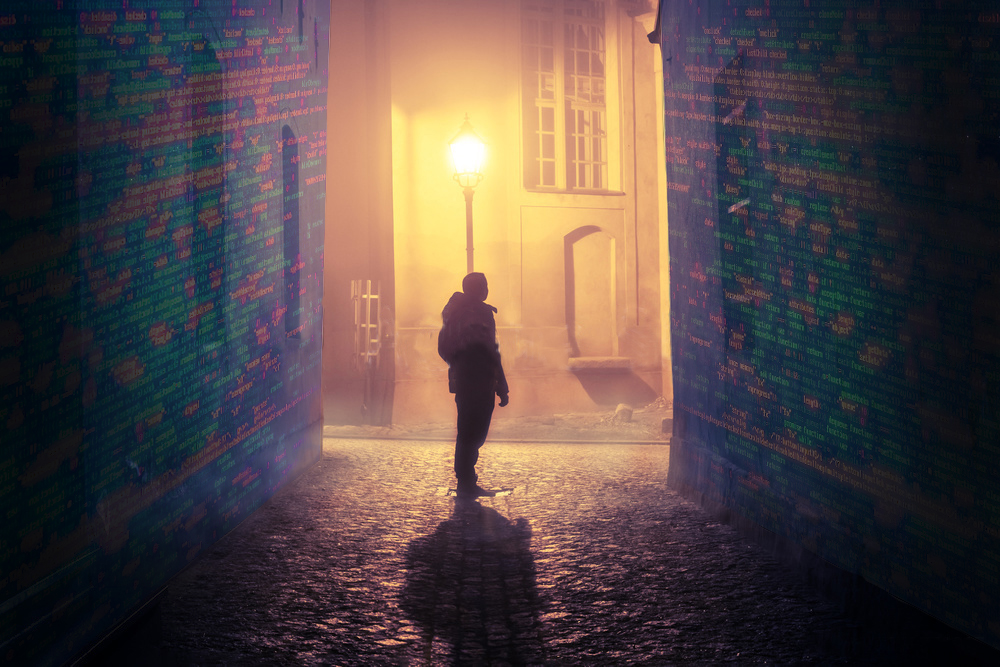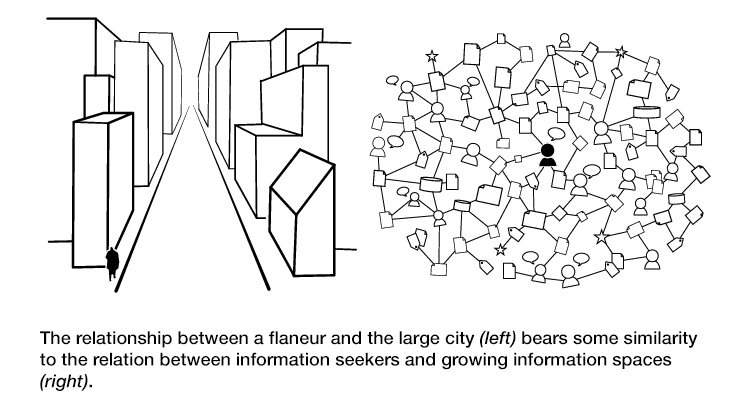I’ve recently been reading articles by Mitchell Whitelaw and Dominic Fee, that have both referenced the term ‘flaneur’ in relation to different aspects of modern archives and information seeking habits. I was quite intrigued by the term, and decide to follow up with some further research.
I came across an article (https://mariandoerk.de/informationflaneur/chi2011.pdf) by Marian Dörk, titled “The Information Flaneur: A Fresh Look at Information Seeking“.
As I will describe, it proved to be a serendipitous find in more ways than one, and articulated quite eloquently many things that I have often thought, but have never been able to express very well, in relation to how I would like the internet to function regarding design and visual layout.

The urban flaneur
The urban flaneur, derived from the French ‘flâneur‘ meaning “stroller“, was a term used to describe a Parisian urban character in the 1840’s https://en.wikipedia.org/wiki/Fl%C3%A2neur:
‘The flanuer appears to have no goal; rather, experiencing city life is his primary aim. Without becoming fully part of it, he passes through squares and crowds making sense of the city. The growing disparity between the large city population and the individual makes it unlikely to meet personal acquaintances by chance. While city life becomes more accelerated, the flaneur keeps a leisurely pace, resisting the growing speed of emerging capitalism. The flaneur moves “through space and among the people with a viscosity that both enables and privileges vision. He explores the city following whatever cue, or indeed clue, that the streets offer as enticement to fascination.” (Dörk et. al. | 2011)
Other important aspects to note of the urban flaneur is a more critical side that is aware of “the accompanying social realities“. The flaneur is a somewhat contradictory character. The flaneur values and notices unseen or under-appreciated aspects of the city’s beauty and design and populace, creating an ‘aestheticisation of everyday life‘. At the same time, they are a cultural critic ‘resisting the commercialisation and acceleration by taking time and ‘walking out of step‘.
The connections to the contemporary online ‘information seeker’ are easy to see. Digital information spaces are in many ways today what major urban cities were back then, functioning as the main cultural platform of exchange and interaction for a large percentage of the world’s population.

Dörk suggests that the urban flaneur is thus an excellent ‘lens through which to envision new perspectives on information seeking‘.
Visual foraging
There are many interesting connections and suggestions that come from looking through the lens of the urban flaneur, feeding into the definition/portrait of a modern information flaneur or information seeker. Some of the ones that I found most interesting and relevant to my research into visual arts archives were the terms ‘visual foraging‘ and the importance of serendipity in the search/research process.
For many visual artists, designers, and illustrators today (especially for younger and emerging visual artists), the research process begins with an image search, or an image gathering across online and offline platforms, amassing elements, styles, and compositions from a variety of sources into a collection of items/images/objects/artefacts. Aspects of this visual collection are then viewed through the lens of personal thematic or conceptual concerns and help develop a starting point(s) for the creation of authentic new work(s) by the artist(s).
This process is very much a ‘visual foraging‘ of the area(s) of interest to the artist, guided in no small part by a serendipitous approach and outlook. Its similar to how one might browse a shop for items, without an idea of exactly what one is looking for, but usually having a broader area of interest; like ‘winter-wear‘, or slightly more specific like ‘something for that sunny patch at the back of the garden‘. The discovery of a new visual of interest often pivots the artist into a slightly new direction, creating a meandering pathway made up of smaller ‘steps’ with varying degrees of ‘pivot‘ in between them.
A nice visual for this in the article is the idea of the information flaneur ‘bumping into information‘.
The problem is that the visual framework of many websites, archives, and databases do not encourage this type of ‘visual foraging‘ and discovery.
‘Visual‘ Explorability
Explicit search techniques, or “Interfaces centred around keyword search and filtering” are identified in the article as impeding these kinds of serendipitous information encounters. An example of designing for serendipitous information encounters include visual information surrogates (an image representing a work of art or ‘parent image’) instead of text abstracts, and faceted navigation . A comparative usability study is referenced in the article comparing explicit search techniques and faceted navigation with 32 art students. The study showed that the art students showed much higher levels of confidence, satisfaction, and recall with a faceted versus search based-interface.
The article finally introduces ‘explorability‘ as “an umbrella goal that integrates principles that have evidence for supporting the information flaneur in cultivating her curiosity, reflection, and imagination.” I would change this goal to ‘visual explorability‘ in the context of my research into visual arts archives, as I think that this principle of visual explorability has the most potential in defining the type of service user I am most looking to create design and functionality for in an arts archive.
Overall I have been inspired by the human centred approach to knowledge seeking that is described in the Dörk article, and I like to think that my own experience in carrying out research for this masters programme follows the model of the ‘information flaneur‘. One of the most exciting aspects to this approach is that you never know what new knowledge is around the corner that you will ‘bump’ into.
This post represents my last one of the semester and the year…looking forward to ‘bumping’ into new things next year!
The immortal words of the the American television artist/painter Bob Ross are called to mind:
Remember friends, there’s no such thing as mistakes; just happy little accidents!
Bob Ross
Dörk, Marian., Carpendale, Sheelagh., Williamson, Carey. ‘The Information Flaneur: A Fresh Look at Information Seeking‘ University of Calgary, Calgary, Alberta, Canada 2011.
Whitelaw, Mitchell. ‘Generous Interfaces for Digital Cultural Collections’ Digital Humanities Quarterly. Volume 9 Number 1. University of Canberra, Australia, 2015.
Fee, Dominic | Artist, exhibition maker and educator based in Cork, Ireland, n.d. URL https://dominicfee.info/ (accessed 10.4.19).
